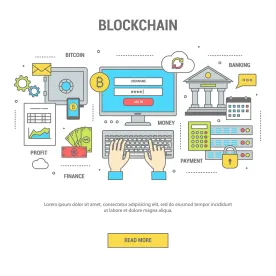In 2018, five major healthcare companies – Humana, MultiPlan, Optum, Quest Diagnostics, and UnitedHealthcare – formed the Synaptic Health Alliance (the “Alliance”) to explore how blockchain technology could resolve current healthcare issues. The Alliance launched its first pilot program in April 2018 to focus on specific ways that “blockchain technology can help ensure the most current information about healthcare providers is available in the provider directories maintained by health insurers.”[1] Aetna and Ascension joined the Alliance in December 2018, thus adding additional resources and unique perspectives to the effort of streamlining provider data management.[2]
What is Blockchain?
As described in a March 1, 2018 article, “How Blockchain Can Impact Healthcare” authored by James Gatto, Esq. and posted on the Law of the Ledger: Legal Issues with Blockchain and Cryptocurrency Blog, a blockchain is, at its core, a distributed ledger for recording transaction data. In short, a blockchain can aptly be described as a simple list of transactions.
Traditional paper-based ledgers include consecutive pages in which each line records a transaction. When a ledger page is full, the process repeats on the next ledger page. In the case of a blockchain, each block is like a page. Transactions get verified and written into a block and when the block is full, a new block is created. Unlike traditional paper-based ledgers, when a block is full, the system creates a hash value, which is just a random number generated by an algorithm based on the contents of the block. This hash value is then written as the first entry in the new block, thereby “chaining” together the blocks, hence the term “blockchain.” If someone ever attempts to change an entry in a prior block, the hash value would no longer match what was written into the new block and that attempt would be deemed invalid. In part, this is how blockchain creates unalterable records.
Current Challenges Surrounding Provider Data Management
Health plans are required to actively maintain and update their provider directories to meet both federal and state regulatory requirements. Provider directories include vital information for determining coverage for patients, including contact information for providers, information about plan participation for individual providers, and information regarding whether an individual provider is accepting new patients. Approximately $2.1 billion is spent annually by insurers, doctors, and hospitals to maintain this provider data.[3]
In addition to astronomical costs, current provider directories often contain inaccurate or outdated information. The Centers for Medicare and Medicaid Services reviewed a pool of Medicare Advantage Organizations and found that “52.20% of the provider directory locations listed had at least one inaccuracy.”[4] The inaccuracies included incorrect address information, errant phone numbers, and misidentification of a provider as presently accepting new patients when the provider was not.[5]
Inaccuracies in provider directories routinely result in issues with coverage for patients. A survey conducted by the American Medical Association and LexisNexis® Risk Solutions found that 52% of physicians in the United States “say they encounter patients every month with health insurance coverage issues due to inaccurate directories of in-network physicians."[6]
Blockchain as a Potential Solution
The Alliance has assessed this current system as inefficient due to the duplicative efforts of health plans that “typically maintain their own provider data sets and rarely collaborate on the daunting task of provider data management.”[7] The end result being redundant administrative expenses and silos of disconnected data.[8]
The Alliance considers blockchain to be a technology that could streamline the current process for maintaining accurate provider data. The Alliance “plans to build a permissioned blockchain that would let members view, input, validate, update and audit non-proprietary provider data within the network.”[9] Specifically this blockchain solution could:
- Improve interoperability among stakeholders by creating “a synchronized, shared source of high-quality provider data” that would be stored via blockchain and begin to connect the currently separated data silos;
- Improve data integrity by creating a tamper-resistant, chronological record of each transaction which will “remain visible and unchanged, providing a real-time audit trail;” and
- Allow “participants to share some of the administrative burden and cost of data maintenance and reconciliation” thus reducing administrative costs for each member.[10]
Provider data is a foundational piece of the healthcare system that connects doctors to patients. This first pilot program by the Alliance could significantly improve current provider data management systems by utilizing blockchain technology as a uniform standard creating interoperability among stakeholders and improving accuracy of submitted data.
[1] Here.
[2] Here.
[3] Here.
[4] Here.
[5] Id.
[6] Here.
[7] Here.
[8] Id.
[9] Id.
[10] Id.




 />i
/>i

